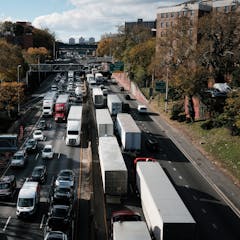
Articles on Bicycles
Displaying 1 - 20 of 38 articles

Ensure your helmet complies with the national or international bicycle helmet standards, which should be stated on the label inside the helmet.

Cycling in Canada has been experiencing a great boom in recent years. Yet, there was no consistent and complete way to measure cycling infrastructure, until now.

Bike riders wear helmets and high-vis vests to reduce their vulnerability on the road. Problem is a new study finds this dehumanises cyclists, putting them more at risk of aggression from drivers.

Noise pollution is a serious problem, and cars make a lot of it. But roads are also a factor.

Three scientists explain the biology and physics of what goes into one of the world’s most grueling races, the Tour de France.

The bicycle’s capacity to respond to pressing social issues has inspired both intrigue and optimism, especially in the context of COVID-19.

Building a culture of cycling is essential, especially where bike use is low. A global movement of community bike workshops, also known as bike kitchens, can help.

London was rated 2021’s most congested city.

It’s time to stop demonising cyclists and cycling activists as elitists — the accusation fails at the first test.

And the winner is … e-bikes? A new entrant is set to overtake Brisbane’s CityCycle scheme in the race for the shared mobility market.

Delivery riders are paying the ultimate price for the fact that our cities, their infrastructure and the rules governing them make cycling much more dangerous than it should be.

An increase in cyclists due to the COVID-19 pandemic means that cities need to look at what it means to develop and maintain inclusive bicycle infrastructure.

If we’re to get more people walking and cycling in our cities, then we need to make it easier for people, and we can learn from others overseas.

City streets were built to accommodate cars, but the COVID-19 pandemic has scrambled our transport needs. Many cities are moving to make streets more people-friendly and less car-centric.

Drivers and cyclists develop distinct identities of themselves and others in ways that mirror the formation of ethnic identities. And on-road segregation runs the risk of reinforcing this process.

In major cities around the world, dockless scooters and bikes are everywhere, yet the companies themselves are often breathtakingly short-lived. Basic economic concepts give us clues why.

Where bikes are kept is a strong pointer to the place of cycling in the owner’s life. Effective active transport policy starts with understanding what stops people using their bikes instead of cars.

The Trump administration has moved to allow electric bikes on all federally owned trails where normal bikes are allowed. A public lands scholar weighs in on the issues this could cause.

Volunteers can contribute data to maps that help cyclists choose their routes and let planners know how city cycling can be improved.

US cities were designed and engineered around cars. Now some are working to increase walking and biking, but the shift isn’t easy.
